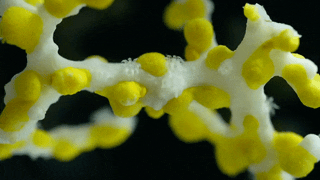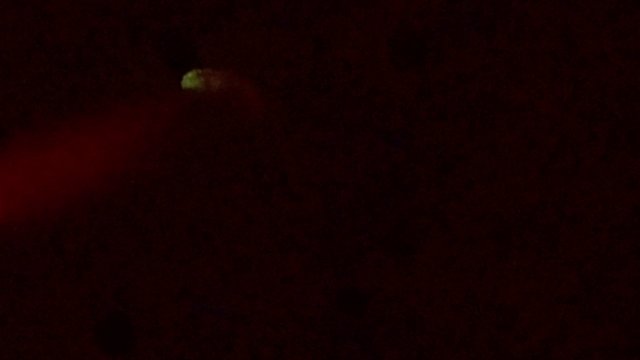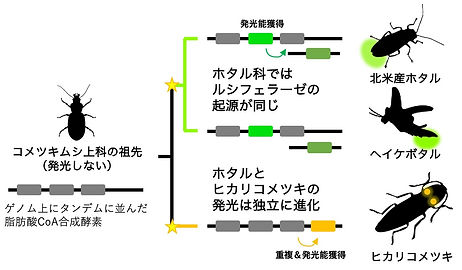知識を体系化し積み重ねてゆくことこそが
地球上で人間にのみ許された行為である。
PUBLICATIONS

Journal Publications
-
Kise, H., Bessho-Uehara, M., et al. (2025). Glow in the D-ARK: a new bioluminescent species of Corallizoanthus (Anthozoa: Zoantharia: Parazoanthidae) from southern Japan. R. Soc. Open Sci.12250890(オープンアクセス)
大東島の深海から発光する新種のスナギンチャクを見つけました。和名のウフアガリとは、現地の方言で大東島を意味しています。種小名のaureusは金色という意味で、生体の鮮やかな体色と光り輝くことにちなんでいます。 -
Bessho-Uehara, M., Jimi, N., & Fujiwara, Y. (2025). A bioluminescent deep-sea polychaete within the genus Aricidea (Paraonidae) from Minamidaito Island, Japan. Scientific Reports, 15(1), 36573. (オープンアクセス)
地質学的に特異な地形を持つ大東島を取り囲む深海へ調査に行き、ヒメエラゴカイ科の一種が発光することを世界で初めて明らかにしました。発光種を含む科が新たに追加されたことになります。この報告で、環形動物門における発光種を含む科の数は15になりました。環形動物は陸でも海でも土壌や海底に潜っていることが多く、発光を観察されていないよう思います。今後もどんどん新しい発光種が見つかってくると考えられます。
また、今回見つかったAricidea属のゴカイは浅瀬でも見つかるらしいです。もしかするとすぐそこの浜辺にも光るゴカイが潜んでいるかもしれません。 -
Bessho-Uehara, M., Kato, T., Ohira, A., Nakamori, T., & Oba, Y. (2025). Biochemical basis of endogenous bioluminescent springtail Lobella sauteri (Collembola). Biology Open, 14(5), bio061829.(オープンアクセス)
ザウテルアカイボトビムシの発光メカニズムの研究第一弾。名古屋大時代の学生の加藤くんが中心となって進めてくれた成果です。トビムシの発光はLuciferin-Luciferase反応であることがわかり、補因子にATPとMg2+を要求することがわかりました。また、脱皮直前にイボが白くなること、さらにその時期に発光が強くなることを明らかにしました。 -
Koeda, K., & Bessho-Uehara, M. (2024). A review of the genus Pempheris (Teleostei, Pempheridae) found in Japan and Taiwan. ZooKeys, 1220, 123.
キンメモドキ属が含まれるハタンポ科魚類の分類学研究です。琉球大学の小枝先生と一緒に国内のハタンポ科魚類の分類系統を再検討しました。光らない魚がどのように光るようになったのか?盗タンパク質はどう進化したのか?を探るための基盤となる研究です。 -
DeLeo, D. M., Bessho-Uehara, M., Haddock, S. H., McFadden, C. S., & Quattrini, A. M. (2024). Evolution of bioluminescence in Anthozoa with emphasis on Octocorallia. Proceedings of the Royal Society B, 291(2021), 20232626.(オープンアクセス)
八放サンゴ類には発光種がたくさんいる、さらに発光の分子メカニズムが共通しているという2020年の研究の続編です。八放サンゴ綱の大規模系統解析と祖先形質推定法により、八放サンゴ類の祖先はおよそ5.4億年前には生物発光能力を獲得していたことを推定した研究。これまで最も起源の古い発光生物はウミホタル類(2.6億年前)でしたが、その記録を2倍更新しました。この時代は、生物の多様性が急増したカンブリア爆発が起きたカンブリア紀に当たります。カンブリア爆発は眼の誕生が引き起こしたという「光スイッチ説」を考えると、需要側の眼の誕生とそれを利用する生物発光の誕生が重なっているのは、何か偶然では片づけられない因果があるように思えてなりません。
(名古屋大学からプレスリリース) -
Bessho-Uehara, M., Mallefet, J., & Haddock, S. H. (2024). Glowing sea cucumbers: Bioluminescence in the Holothuroidea. In The world of sea cucumbers (pp. 361-375). Academic Press.
ナマコも光るんです!
最新の分子系統解析の結果を取り入れた祖先形質推定により、ナマコ類ではおそらく6回も独立に生物発光能力を獲得していたことがわかりました。全ての発光種が200 m以深の深海に棲んでいるため、これまでほとんど研究が進んでいません。また、そのうち板足目のナマコの仲間の共通祖先はなんと1.8億年前にはすでに発光していたことも推定されました。現在深海にいるナマコも200種以上が、発光する祖先から発光能力を受け継いでいる可能性が考えられます。今後の調査で多くの発光種が見つかるのではないかとワクワクしています。
(名古屋大学からプレスリリース)
-
Ohira, A., Nakamori, T., Matsumoto, S., Bessho-Uehara, M., Kato, T., & Oba, Y. (2023). Contribution to the taxonomy of Lobellini (Collembola: Neanurinae) and investigations on luminous Collembola from Japan. Zootaxa, 5325(1), 63-89.
六本脚を持つ虫なのに厳密には昆虫ではない、そんな不思議なトビムシという生物の中でもさらに不思議な光るトビムシの正体を明らかにしたという研究。古くは江戸時代の薬草図鑑の一節に登場する光るトビムシ。その存在は日本だけでなく世界各地で断片的に報告されていたのですが、その正体は不明でした。というのも、トビムシは分類学があまり進んでおらずどの種が発光するのかについてはわかっていなかったのです。大平博士と中森博士らによる詳細な形態観察、遺伝子解析、さらに、世界中の博物館に収蔵されている標本を徹底的に調べ上げたことで世界で初めて種名がはっきりとわかった光るトビムシです。その名もザウテルアカイボトビムシ。その発光の様子を映像で記録することにも世界で初めて成功しました。
(名古屋大学、横浜国立大学からプレスリリース)
-
Jimi, N., Bessho-Uehara, M., Nakamura, K., Sakata, M., Hayashi, T., Kanie, S., ... & Ogoh, K. (2023). Investigating the diversity of bioluminescent marine worm Polycirrus (Annelida), with description of three new species from the Western Pacific. Royal Society open science, 10(3), 230039. (オープンアクセス)
名古屋大学の菅嶋臨海実験所にて、新種の発光ゴカイPolycirrus属を3種発見した論文。この仲間をヒカリフサゴカイ属と和名をつけ、それぞれオニビフサゴカイ、イケグチフサゴカイ、アオアンドンフサゴカイと和名もつけました。多毛類の分類学者である自見直人先生(名古屋大)の研究に、生物発光の観察・記録として協力させてもらいました。
(名古屋大学からプレスリリース)
-
Yano, D., Bessho-Uehara, M., Paitio, J. et al. 14-3-3 proteins are luciferases candidate proteins from lanternfish Diaphus watasei. Photochemical & Photobiological Sciences (2022). https://doi.org/10.1007/s43630-022-00311-2
深海魚ハダカイワシのルシフェラーゼを精製画分から、14−3−3タンパク質が検出された。
-
Ramesh, Chatragadda, and Manabu Bessho-Uehara. "Acquisition of bioluminescent trait by non-luminous organisms from luminous organisms through various origins." Photochemical & Photobiological Sciences 20, no. 11 (2021): 1547-1562.
生物が新しい機能を獲得する進化のプロセスには、ゲノムに新しい変異を獲得する以外にも、別の方法がいくつか知られています。例えば、遺伝子水平伝播や共生、そして、餌生物による鍵となる物質の獲得などが挙げられます。このような、いわゆる別解のような方法で発光能力を獲得した進化の方法、あるいはそのポテンシャルを持つ事例についてまとめた総説論文です
-
Bessho-Uehara, Manabu, et al. "Evidence for de novo Biosynthesis of the Luminous Substrate Coelenterazine in Ctenophores." iScience 23.12 (2020): 101859. (オープンアクセスです)
海洋発光生物にとってなくてはならない分子セレンテラジンは、これまで、誰がどのように作っているのかについてほとんどわかっていませんでした。水族館とのコラボレーションにより、クシクラゲがセレンテラジンの生産者であることを突き止めました。
(名古屋大学からプレスリリース)
-
Bessho-Uehara Manabu, Warren R. Francis, and Steven HD Haddock. "Biochemical characterization of diverse deep-sea anthozoan bioluminescence systems." Marine Biology 167.8 (2020): 1-19.(オープンアクセスです)
花虫綱(サンゴやイソギンチャク、ヤギ)の発光の進化を明らかにするため深海の発光種を調査した。八放サンゴ亜綱(ウミシイタケやヤギ、ソフトコーラルの仲間)の発光メカニズムが共通していることから、発光の起源が八放サンゴ亜綱の共通祖先である可能性が示唆された。さらに、これまで発光することが知られていなかったイソギンチャク(六放サンゴ亜綱)1種とソフトコーラルなど八放サンゴ亜綱で3種(うち2つが新しい亜目、科)が新たに発光種であることを発見した。Blogに解説あります。PR動画も必見です。
この研究はJournalのEditorによりHighlight Articleに選ばれました。Editorial
(名古屋大学からプレスリリース)
-
Bessho-Uehara Manabu, Naoyuki Yamamoto, Shuji Shigenobu, Hitoshi Mori, Keiko Kuwata, and Yuichi Oba. "Kleptoprotein bioluminescence: Parapriacanthus fish obtain luciferase from ostracod prey." Science Advances 6, (2020): eaax4942. (オープンアクセスです)
浅海性の発光魚キンメモドキのルシフェラーゼがウミホタルのルシフェラーゼであることを発見。盗タンパク質現象を世界で初めて発見、概念の提唱をした。Blogに解説があります。
(JSTからプレスリリース)
-
Timothy R Fallon, Sala E Lower, Chin-Ho Chan, Manabu Bessho-Uehara, Gravin J Martin, Adam J Bewick, Megan Behringer, Humberto J Debat, Isaac Wong, John C Day, Anton Suvorov, Christian J Silva, Kathrin F Stanger-Hall, David W Hall, Robert J Schmitz, David R Nelson, Sara M Lewis, Shuji Shigenobu, Seth M Bybee, Amanda M Larracuente, Yuichi Oba, Jing-Ke Weng. "Firefly genomes illuminate parallel origins of bioluminescence beetles." eLife (2018).(オープンアクセスです)
ホタル2種(ヘイケボタルとアメリカのピラリス)とヒカリコメツキ1種のゲノムを比較した論文。配列情報はFirefly baseでオープンになっており、web server上でBLASTなどもできる。発光甲虫は[ホタル・フェンゴデス・イリオモテボタル]の系統と、[ヒカリコメツキ]の2つの系統にまとまっている。二つの系統が離れているにも関わらず、ルシフェリンの構造が同一であり、また、ルシフェラーゼ遺伝子の相同性が高いことからこれらの昆虫における発光の進化が1回なのか複数回だったのかは、ダーウィン時代から長く続く論争であった。本論文の主な発見の一つに、ホタルとコメツキは進化の過程で独立に発光を獲得したことがわかった。
そのほかにも、ホタルの発光器に特有な遺伝子や、毒(ルシブファジン)に関する遺伝子、共生バクテリアがいるかもしれないこと、発光器に特有のオプシンが発現していることなどを新たに報告した。
(基礎生物学研究所からプレスリリース)
-
Bessho-Uehara, Manabu, Kaori Konishi, and Yuichi Oba. "Comparative analysis of firefly luciferase genes: Evolution of the intron-exon structure." Lampyrid (2017).
ホタル亜科とマドボタル亜科でLuc2が取れてきたので、その遺伝子構造がluciferaseの進化の中でどれくらい保存されているかを調べた研究。結果はホタル科の中で、既知のルシフェラーゼはLuc1もLuc2もどちらもその遺伝子構造、すなわちイントロンとエキソンの位置関係は完全に保存されていた。ただし、1種だけ例外があった(後述)。さらに、コメツキも含めた解析を行い、甲虫ルシフェラーゼでは、すべて7 exon-6 intronのパターンとそのジャンクションの位置が保存されていた。先の例外というのが、韓国の研究者が調べた韓国産と中国産のアキマドボタルPyrocoelia rufaのLuc1(PrLuc1-K&C)では、イントロンの位置が60 nucleotide (nt) 5'側にずれていた。Intron sliding/ shiftは1-15 nt の範囲では知られているが、60 ntと長いずれは知られていない。これらの個体の入手は困難なので、対馬に生息するアキマドボタルを使って、Luc1の遺伝子構造を調べたところ、他のLuc1と同じ形だったので、どうやら先人のミスの可能性が高そう。
-
Manabu Bessho-Uehara, Kaori Konishi, and Yuichi Oba. "Biochemical characteristics and gene expression profiles of two paralogous luciferases from the Japanese firefly Pyrocoelia atripennis (Coleoptera, Lampyridae, Lampyrinae): Insight into the evolution of firefly luciferase genes." Photochemical & Photobiological Sciences (2017).
沖縄の八重山諸島に生息するヤエヤママドボタル(オオシママドボタルとも)から2つのルシフェラーゼPatLuc1とPatLuc2を発見し、その生化学的性質や遺伝子発現部位を発生ステージ(成長段階)別に調べた研究。その結果、ホタル科は全てLuc1とLuc2をもち、それらの使われ方が共通していることが示唆された。これはホタル科の共通祖先で発光能力が獲得されたあと、ルシフェラーゼの遺伝子重複と発現時期の使い分けが、亜科に分岐するまでの進化的にごく短い時間でほぼ同時に起こった可能性を示唆している。
-
Bessho‐Uehara, Manabu, and Yuichi Oba. "Identification and characterization of the Luc2‐type luciferase in the Japanese firefly, Luciola parvula, involved in a dim luminescence in immobile stages." Luminescence (2017).
名古屋大学で捕まえたヒメボタルを使った研究。陸棲ホタルにもLuc2があることが明らかとなった。ホタルの発光器からの発光色は、Luc1によって生み出され、緑から黄色まで様々である。発光器(Luc1)が黄色く光るヒメボタルでも、蛹(Luc2)の発光色は緑色であることがわかった。おそらく、Luc2は毒を持つことの警告のために使われており、他生物の視覚感受に適したスペクトルにチューニングされているのだろう。
-
Oba, Yuichi, Furuhashi, Mana, Bessho, Manabu, Sagawa, Shingo, Ikeya, Haruyoshi, and Inouye, Satoshi. "Bioluminescence of a firefly pupa: involvement of a luciferase isotype in the dim glow of pupae and eggs in the Japanese firefly, Luciola lateralis." Photochemical & Photobiological Sciences 12.5 (2013): 854-863.
ゲンジボタルはルシフェラーゼを2つ持つことが2010年に明らかとなったが、2つの遺伝子がどう使い分けられているのかはわかっていなかった。飼育が可能なヘイケボタルを使うことで、Luc2を持つことを明らかにし、さらに、Luc1とLuc2がどのように使い分けられているのかを明らかにした。Luc1は幼虫と蛹、成虫の発光器で発現しており、Luc2は卵と蛹、メス成虫の卵巣で発現していた。













Academic Presentations
Invited Presentations
-
Manabu Bessho. Pupal Bioluminescence of Luciola parvula. The 12th Summit of Luciola parvula in Aichi. May 26, 2013. Plenary talk
International Presentations
-
Manabu Bessho-Uehara. Evolution of bioluminescence in the sea. Moss Landing Marine Laboratories Seminar. U.S.A. Feb 20, 2020. Oral
-
Manabu Bessho-Uehara, Warren R. Francis, Steven HD Haddock. Biochemistry of Deep-sea Gelatinous Luminous Animals. 15 th Deep-Sea Biology Society, USA, Sep 9-14, 2018. Poster
-
Manabu Bessho-Uehara. Evolution of beetle luciferase: a view from genomes and transcriptomes. 20th International Symposium of Bioluminescence and Chemiluminescence, France. May 27 – Jun 1, 2016. Oral
-
Manabu Bessho, Yuichi Oba. Conservative green luminescent color in pupal bioluminescence: Identification of firefly luciferase paralog from the Japanese terrestrial firefly, Luciola parvula. 19th International Symposium of Bioluminescence and Chemiluminescence, Japan. May 29 – June 2, 2016. Oral
-
Kaori Konishi, Manabu Bessho, Yuichi Oba. Isolation of Luciferase isotypes from Lampyrinae. 19th International Symposium of Bioluminescence and Chemiluminescence, Japan. May 29 – June 2, 2016. Poster
-
Manabu Bessho, Yuichi Oba. Purification of a novel luciferase from luminous fish, Parapriacanthus ransonneti. 18th International Symposium of Bioluminescence and Chemiluminescence, Sweden. June 23-28, 2014. Poster
-
Yuichi Oba, Mana Furuhashi, Manabu Bessho, Shingo Sagawa, Haruyoshi Ikeya, Satoshi Inouye. Luciferase isotype involving in the dim glow of pupae and eggs in the Japanese firefly, Luciola lateralis. 18th International Symposium of Bioluminescence and Chemiluminescence, Sweden. June 23-28, 2014. Oral
-
Yuichi Oba, Manabu Bessho, Shusei Kanie. Evolution of firefly luciferase and biosynthetic origin of firefly luciferin. 2014 International Firefly Symposium, USA. August 11-15, 2014. Oral
Domestic Presentations
-
Manabu Bessho-Uehara. Kleptoprotein Bioluminescence. Yosakoi Ecology Seminar. June 16, 2020. Online. (available on YouTube, in Japanese)
-
Manabu Bessho-Uehara. Comparative Genomic analysis reveals Evolution of luciferase in firefly. Firefly genome meeting at NIBB. January 2019. Oral.
-
Manabu Bessho-Uehara. Gene expression profiles of two paralogous firefly luciferase. The 10th meeting of The Rising Generation of Evo-Devo Biologists. June 17-18, 2017. Poster
-
Manabu Bessho. Bioluminescence diversity of firefly underlying gene duplication. 3rd Eco-Evo-Devo Colloquium, Japan. December 28, 2015. Oral
-
Manabu Bessho, Shuji Shigenobu, Katsushi Yamaguchi, Naoyuki Yamamoto, Yuichi Oba. The evolution of bioluminescence of Luminous fish, Parapriacanthus ransonneti, emitting light by preying cyprinid. 16th Annual meeting of Society of Evolutionary Studies, Japan. August 20-23, 2015. Oral
-
Manabu Bessho. Study of bioluminescent mechanism of Parapriacanthus ransonneti that emits light by eating cyprinids. First workshop of Evolutionary study, Japan. March 26-27, 2015. Oral
-
Manabu Bessho. Evo-devo of photophore among fish. The 7th meeting of The Rising Generation of Evo-Devo Biologists”, Japan. Octover 11-12, 2014. Poster
-
Manabu Bessho, Yuichi Oba. Histological investigation and purification of luciferase form luminous fish Parapriacanthus ransonneti. 16th Annual meeting of Society of Evolutionary Studies, Japan. Augest 21-24, 2014. Poster
-
Manabu Bessho, Mana Furuhashi, Shingo Sagawa, Yuichi Oba. Luciferase isotype involving in the dim glow of pupae and eggs in the Japanese firefly, Luciola lateralis. 168th Chubu regional Conference of the Japan Society for Bioscience, Biotechnology and Agrochemistry. Octorber 12, 2013. Oral
-
Manabu Bessho, Yuichi Oba. Investigation of genes involving bioluminescent traits from lantern fish by RNA-seq. 15th Annual meeting of Society of Evolutionary Studies, Japan. Augest 28-31, 2013. Oral